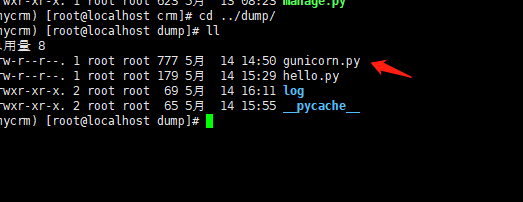1.一个简单的flask项目
hello.py 文件
from flask import Flask
app = Flask(__name__)
@app.route("/")
def index():
return "hello"
if __name__ == '__main__':
app.run(host='0.0.0.0', port=8000, debug=True)
2. 虚拟环境使用
https://www.cnblogs.com/sc-1067178406/p/10624075.html
3. gunicorn 配置
pip3 install gunicorn
①添加 gunicorn.py 文件

gunicorn.py 文件
# -*- coding: utf-8 -*- import os import gevent.monkey gevent.monkey.patch_all() import multiprocessing debug = True loglevel = 'debug' bind = '0.0.0.0:8000' log_dir = os.path.join(os.path.dirname(__file__), 'log') if not os.path.exists(log_dir): os.makedirs(log_dir) p = os.path.join(log_dir, 'gunicorn.pid') j = os.path.join(log_dir, 'debug.log') a_ = os.path.join(log_dir, 'access_log.log') e_ = os.path.join(log_dir, 'error_log.log') accesslog = a_ errorlog = e_ pidfile = p logfile = j #启动的进程数 workers = multiprocessing.cpu_count() * 2 + 1 worker_class = 'gunicorn.workers.ggevent.GeventWorker' x_forwarded_for_header = 'X-XUBOGZF-FOR' print("项目启动")
② 测试启动
gunicorn -w 4 -b 0.0.0.0:5000 hello:app
4. 安装 supervisor
https://www.cnblogs.com/sc-1067178406/p/10645966.html#_label2
①添加配置
(加在 supervisor.conf 文件最后 )
[program:housing] directory=/html/dump command=/root/Envs/mycrm/bin/gunicorn -c /html/dump/gunicorn.py hello:app autorestart=true user=root redirect_stderr=true ; redirect proc stderr to stdout (default false) stdout_logfile = /var/log/supervior/crm.log stderr_logfile = /var/log/supervior/crm-err.log stdout_logfile_maxbytes=50MB ; max # logfile bytes b4 rotation (default 50MB) stdout_logfile_backups=10 ; # of stdout logfile backups (default 10)

②web的管理界面(打开 supervisor.conf 中的注释)
[inet_http_server] ; inet (TCP) server disabled by default port=127.0.0.1:9001 ; (ip_address:port specifier, *:port for all iface) username=user ; (default is no username (open server)) password=123 ; (default is no password (open server)) [supervisorctl] serverurl=unix:///tmp/supervisor.sock ; use a unix:// URL for a unix socket serverurl=http://127.0.0.1:9001 ; use an http:// url to specify an inet socket username=user ; should be same as http_username if set password=123 ; should be same as http_password if set ;prompt=mysupervisor ; cmd line prompt (default "supervisor") ;history_file=~/.sc_history ; use readline history if available
③ 启动
启动 supervisord -c /etc/supervisor.conf
status housing #查看状态
start housing #启动任务
stop housing #停止任务
start all
stop all #启停所有的任务
5.nginx 配置
①安装
https://www.cnblogs.com/sc-1067178406/p/10639740.html
② .conf 文件 配置
server { listen 9999; server_name _; #服务 location / { client_max_body_size 100m; proxy_pass_header Server; proxy_set_header Host $http_host; proxy_redirect off; proxy_set_header X-Real-IP $remote_addr; proxy_set_header X-Scheme $scheme; proxy_pass http://0.0.0.0:8000; } location /status { stub_status on; } }